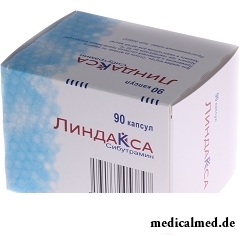





Lindaksa
Application instruction:
 Lindaksa – anorexigenic means, strengthens feeling of saturation.
Lindaksa – anorexigenic means, strengthens feeling of saturation.
Form of release and structure
Dosage form – capsules: gelatinous firm with the yellow case and lids of two types, one type of capsules has a lid of brown color and marking of the "10", second – a blue lid and marking "15"; in capsules – almost white or white powder (on 10 pieces in blisters, in a cardboard pack of 3 or 9 blisters).
Active ingredient of Lindaksa – a sibutramin of a hydrochloride monohydrate, in 1 capsule – 10 mg or 15 mg.
Auxiliary components: magnesium stearate, cellulose microcrystallic, lactoses monohydrate, silicon dioxide colloid anhydrous.
Structure of the case of the capsule: gelatin, titanium dioxide, dye the Sunset yellow, dye quinolinic yellow, ink black 1012 (ferrous oxide black, shellac, N butanol, lecithin soy, the ethanol denatured (industrial metilirovanny alcohol), the defoaming agent DC 1510).
Structure of lids of capsules:
- Lid of brown color: gelatin, dye ferrous oxide red, dye ferrous oxide black, titanium dioxide;
- Lid of blue color: gelatin, dye indigo carmine, titanium dioxide.
Indications to use
Lindaksa's use is shown for treatment of alimentary obesity at patients with a body weight index:
- 30 kg on sq.m and more;
- 27 kg on sq.m and more at patients with a diabetes mellitus of type 2, a dislipoproteinemiya.
Contraindications
- Heavy disturbances of food (bulimia or anorexia);
- Organic reason of obesity;
- Concomitant use with Lindaksa of monoamine oxidase inhibitors (MAO) (including ephedrine, phentermine, дексфенфлурамин, фенфлурамин, ethylamphetamine) or their use in the last 2 weeks before purpose of drug, hypnagogues, inhibitors of the return serotonin reuptake, tryptophane of the containing means, other drugs for weight reduction of a body of the central action;
- Syndrome Gilles de la Turetta (generalized chronic tic);
- Mental pathologies;
- Cerebrovascular diseases (tranzitorny disturbances of cerebral circulation, stroke);
- Heart pathologies (coronary heart disease, inborn heart diseases, chronic heart failure in decompensation stages, occlusal diseases of peripheral arteries, arrhythmia, tachycardia);
- Arterial hypertension with an uncontrollable arterial pressure (AP) over 145/90 mm of a mercury column;
- The expressed renal failures and/or a liver;
- Thyrotoxicosis;
- Hyperplasia (high-quality) prostate;
- Closed-angle glaucoma;
- Pheochromocytoma;
- The diagnosed medicinal, alcohol, drug addiction;
- The age is more senior than 65 years;
- Age up to 18 years;
- Period of pregnancy and breastfeeding;
- Hypersensitivity to drug components.
With care it is necessary to appoint drug sick with chronic heart failure, arrhythmia in the anamnesis, arterial hypertension (controlled or in the anamnesis), cholelithiasis, neurologic disturbances, including spasms and a delay of intellectual development (including the anamnesis), verbal and motor tics in the anamnesis, renal failures and/or a liver of average and easy severity.
Route of administration and dosage
Capsules accept inside, swallowing entirely and washing down with a glass of water, in the morning, 1 time a day, irrespective of meal.
The attending physician establishes a dose individually, considering portability and clinical performance of drug.
The recommended daily dosing: an initial dose – 10 mg. At a speed of weight reduction of a body and good tolerance of drug a dose it is possible to increase less than 2 kg a month to 15 mg. A course of treatment – no more than 2 years.
It is inexpedient to continue treatment in a case:
- If increase in a dose does not give clinical effect and weight reduction of a body within a month does not exceed 2 kg;
- If after three months of therapy the patient did not lose the weight for 5% of initial body weight;
- If after originally reached weight reduction of a body against the background of use of drug for the patient addition of body weight on 3 kg and more is observed.
Side effects
Lindaksa's use can cause side effects which are noted more often within the first 4 weeks of treatment and have reversible and easy character:
- Nervous system: often – sleeplessness; sometimes – taste change, dizziness, a headache, paresthesias, concern;
- Cardiovascular system: sometimes – tachycardia (pulse increases by 3-7 beats per minute), a heart consciousness, increase in the ABP by 1-3 mm of a mercury column at rest, a vazodilatation (inflows, a dermahemia); in some cases – more expressed increase in pulse and the ABP;
- Alimentary system: often – a lock, appetite loss, dryness in a mouth; sometimes – nausea;
- Others: sometimes – an exacerbation of hemorrhoids, increase in sweating; in isolated cases – a skin itch, hypostases, a dysmenorrhea, a grippopodobny syndrome, thirst, a dorsodynia and/or in a stomach, rhinitis, paradoxical increase in appetite, drowsiness, a depression, emotional lability, irritability, uneasiness, nervousness, bleedings, acute intersticial nephrite, Shenleyna-Genokh's purpura, thrombocytopenia, spasms, tranzitorny increase in activity of liver enzymes in a blood plasma.
The case of development of acute psychosis in the patient with schizoaffective disturbance is described.
Special instructions
Only those patients for whom the attempt of weight reduction of a body exercise stresses and a rigid diet was ineffective should appoint Lindaksa's use, and after 3 months of efforts decrease in weight made less than 5 kg.
Treatment has to take place under control of the experienced specialist in the field of treatment of obesity.
Clinical performance of drug is reached as a part of the complex therapy including not only culture of healthy nutrition and exercise stresses, but also change of a former way of life and the patient's habits. Non-compliance with strict requirements of the doctor does not give a weight reduction guarantee during treatment and leads to increase in weight of the patient after drug withdrawal.
At use of a sibutramin it is necessary within the first two months regularly (1 time in 2 weeks) to control pulse and the patient's ABP, then – once a month. At the accompanying arterial hypertension control needs to be carried out more often and more carefully. Patients at whom the ABP twice at control measurement exceeds the level of 145/90 mm of a mercury column should suspend treatment.
With care patients are recommended to appoint drug with a hypomagnesiemia and other conditions or a concomitant use of the drugs extending QT interval. Antiarrhytmic means (quinidine, Amiodaronum, соталол, флекаинид, пропафенон, мексилетин), blockers histamine H1 receptors (терфенадин, астемизол), цизаприд, сертиндол, Pimozidum, tricyclic antidepressants belong to such drugs.
The interval between purpose of a sibutramin and reception of furasolidone, Procarbazinum, selegilin and other MAO inhibitors has to be more than 2 weeks.
Influence of drug on development of primary pulmonary hypertensia is definitely therefore the patient needs to watch closely possible standing, the progressing and thorax not established.
At the accidental admission of the next dose it is not necessary to accept a double dose of drug at the following reception, and to continue reception according to the scheme.
Reactions of an organism to Lindaksa's cancellation in the form of a headache and the increased appetite are observed seldom. There are no data on disturbance of mood or development of an abstinence syndrome and a withdrawal after the therapy termination.
Alcohol intake during administration of drug is contraindicated.
The medicines influencing a nervous system can limit the speed of reactions, intellectual activity and memory. Therefore during administration of drug patients are recommended to be careful when performing potentially dangerous types of activity requiring special attention and high speed of psychomotor reactions including control of motor transport.
Medicinal interaction
CYP3A4 isoenzyme inhibitors (cyclosporine, erythromycin, кетоконазол, тролеандомицин) against the background of Lindaksa's reception increase concentration of metabolites of a sibutramin and lead to increase in pulse and insignificant lengthening of an interval of QT.
Acceleration of metabolism of drug can exponentiate a concomitant use of antibiotics of group of macroleads, rifampicin, Phenytoinum, phenobarbital, carbamazepine and dexamethasone.
Exceptional cases of development of a serotoninovy syndrome can be observed at a combination of a sibutramin with sumatriptany, dihydroergotamine and other drugs against migraine, antidepressants, antibechics (dextromethorphan), strong analgetics (pethidine, pentazocine, fentanyl).
Drug does not exert impact on efficiency of oral contraceptives and on effect of ethanol.
Terms and storage conditions
To store at a temperature up to 30 °C. To protect from children.
Period of validity – 2 years.
The weight of a human brain makes about 2% of all body weight, however it consumes about 20% of the oxygen coming to blood. This fact does a human brain extremely susceptible to the damages caused by shortage of oxygen.

Eyes – one of the most vulnerable areas on a face therefore age changes concern them first of all. Whether it is possible to keep a pier...
Section: Articles about health
Women quite often suffer from complexes concerning the sizes of the bust. Strangely enough, not too modest, and excessively curvy shapes become the reason of sincere discomfort sometimes. Except psychological problems, a big bust sometimes with...
Section: Articles about health
Producers of milk mixes for children assure: mixes are ideally balanced and adapted for needs of babies. If mother should raise artificially the kid owing to serious problems with health, to do nothing – it is necessary to feed with substitutes of milk. However pediatricians note that not seldom women without good reasons refuse feeding of the child a breast and pass to milk mixes. Common causes of such decision – the aspiration to leave quicker...
Section: Articles about health
Feeding by a breast - the integral part of ideal motherhood allowing to come into contact with the kid and to create since early years...
Section: Articles about health
The name of this disease precisely reflects the problem reason: it consists in the bra fastener pressure upon a certain zone of a back. At the same time one of vertebrae of chest department of a backbone is as if blocked and loses mobility, and falling on it is nude...
Section: Articles about health
The business lady, the become mother, it is necessary to solve an array of problems. But of them is main: how to combine the beloved child and work? What traps trap the working mother and how she needs to behave?...
Section: Slideshow
Today about 30 diseases, sexually transmitted are known. To wide circulation of these illnesses extremely with...
Section: Articles about health
Aging — natural and inevitable process. Over time our skin loses elasticity, on it saggings are formed, the face form loses former clearness. The procedure of nitevy lifting (nitevy tightening) can successfully solve this problem. In order that it is better познако...
Section: Articles about health
Extracorporal fertilization – one of the most modern methods of controlling with infertility. So far he already helped a significant amount of married couples to become happy parents. Usually to the EKO procedure difficult and very expensive, resort in those situations when all other ways to help couple to bring the child are inefficient. "Conception in a test tube" yields quite good results in cases of infertility of one of partners, existence at the woman of impassability of uterine tubes...
Section: Articles about health
On the head of the person about one million hair follicles, or as they are called still, hair bulbs are located. At the moment he is born...
Section: Articles about health
Season of activity of viral infections in the heat. Everyone can get sick, but probability of this unpleasant event it is possible and it is necessary to minimize. There is a number of rules, following to which will help or to avoid absolutely infection with flu or a SARS, or to have an illness...
Section: Articles about health
Dogrose – one of the most widespread adornment and medicinal plants growing practically in all territory of our country. To most of Russians it is a beautiful bush it is known, first of all, as a source of fruits, extremely vitamin-rich. However curative properties of a dogrose are not limited to it at all. About how still it is possible to use a plant in the medical purposes, we will tell today....
Section: Articles about health
The cosmetics intended for improvement of a condition of skin, nails and hair are used by each woman. Expenses on регуля...
Section: Articles about health
Water with a lemon - idle time in preparation drink which supporters of a healthy lifestyle already managed to appreciate. Used in a warm look and on an empty stomach, it is one of the most useful prophylactics allowing to prevent tens з...
Section: Articles about health
Life expectancy in various regions of Earth is not identical. Social stability, economic wellbeing, availability and level of medical care, household comfort, literacy of the population in the field of respect for sanitary and hygienic norms and many other factors exert impact on it. However one parameter remains to the general almost for all countries of the world: women on average live for 7-10 years longer, than men. Today we will talk about the reasons of this phenomenon....
Section: Articles about health
Milk and products of its processing by right occupy one of the main places in a diet of the modern person. They contain necessary...
Section: Articles about health
All got used long ago that, having addressed the plastic surgeon, it is possible to modify natural parameters of a figure or to minimize the damages put to appearance with ruthless time. Many people (preferential women) worldwide е...
Section: Articles about health
We live during an advertizing era. Daily each person receives a solid portion of persuasive councils about what to eat to be healthy and successful. Products about which we will talk today are combined by the following circumstance: all of them are positioned as the most useful and the most suitable for inclusion in a morning meal. Unfortunately, it is not true: these 10 products do not suit for breakfasts at all....
Section: Articles about health
When overcomes feeling of hunger, and an opportunity to have dinner fully is absent, having a snack − small on volume comes to the rescue...
Section: Articles about health
Deciding to get rid of an addiction, not all imagine what effects it is necessary to face. Process of refusal of smoking causes quite essential discomfort in most of people: differences of mood, sleep disorder, fatigue, decrease физич...
Section: Articles about health
About 10-15 years ago existence of the computer in the apartment of the Russian was considered as a rarity and office rooms were only at the first stage of equipment by these useful devices. Today practically in each house there is a computer (and often not one), and a regular user is already every our second compatriot. Convenience and efficiency of personal computers are undoubted, but the people working with them daily have to know also about health hazard which they can predstavlit...
Section: Articles about health
Each person knows that fervescence is an illness sign. However about existence of diseases can to suite...
Section: Articles about health
Healthy lifestyle today in fashion, and many parents think of that the child from the early childhood played sports. Trainings will help it to become strong and hardy, will improve coordination of movements, and also will exert positive impact on mentality: it...
Section: Articles about health
Epilepsy is one of widespread neurologic diseases. Parents, whose children suffer from this illness, should face rumors and delusions, many of which remained since the Middle Ages....
Section: Articles about health
Ability of an organism to resist to adverse environmental factors (to impact of temperature drops, humidity and pressure...
Section: Articles about health
About 20% of the population of our planet have a hypertension (permanent increase in arterial pressure). This disease has an adverse effect on the standard of living, reduces working capacity, and in the absence of systematic treatment threatens with such complications as a heart attack...
Section: Articles about health
The kid who was recently born is surrounded with love of adult family members and their cares without which the baby cannot exist. Some parents consider that gentle attachment and caress are quite enough that the child correctly developed and was happy, but it not so. It is important to know as much as possible about specifics of care of the baby, the reasons of his behavior and possible problems. Only the "able to see" love will provide to the little man that it is necessary for him....
Section: Articles about health
